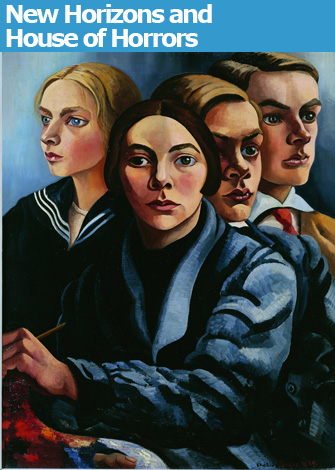 |
|
“Reflection with Two Children (Self-Portrait),” 1965. Photo © José Loren, Museo Thyssen-Bornemiska, Madrid © Lucian Freud |
Anyone who lives in Paris has probably noticed a poster in the street and Métro showing a striking portrait of a big-eyed, rather mannish-looking woman staring forthrightly at the viewer. The woman is Charley …
 |
|
“Reflection with Two Children (Self-Portrait),” 1965. Photo © José Loren, Museo Thyssen-Bornemiska, Madrid © Lucian Freud |
Anyone who lives in Paris has probably noticed a poster in the street and Métro showing a striking portrait of a big-eyed, rather mannish-looking woman staring forthrightly at the viewer. The woman is Charley Toorop (1891-1955), a Dutch painter who is currently the subject of a retrospective (through May 9) at the Musée d’Art Moderne de la Ville de Paris.
Don’t be surprised if you have not heard of her. Few in France have, and the museum should be thanked for bringing her to our attention. Although she was trained by her artist father, Jan Toorop, and hobnobbed with Piet Mondrian and Fernand Léger, Toorop was an original, and her paintings make a refreshing change from the usual suspects, in part because they are unfamiliar. The early paintings in the first room, when Toorop was experimenting with Luminism and Expressionism, are rather awkward, but once Toorop had found her style, the paintings are full of self-assurance and power.
Since she painted so many self-portraits, the show offers a record of the aging process of one person, from blooming youth to wrinkled, white-haired old age, unsparingly painted and always with that unsettling stare.
While her family often served as her subject, Toorop’s paintings are never sentimental or girly, even when the subject is flowers, which in her hands are a forceful explosion of color. All of her paintings have a strong presence and massive volumes, even her still lifes and group portraits. In one of the latter, “Repas des Amis” (1932-33), she crowds the heads of 13 people (plus one gray, statue-like head in the back), all posing rigidly, into the frame in front of the elements of a simple meal: fish, bread, fruit, wine. In another, the fascinating “Famille de Paysans” (1927), the members of a farm family are placed physically close to each other while seeming to have no psychological connection. Only the mother exhibits some life and movement. This painting shows the influence of the Dutch masters of Toorop’s heritage without being in any way imitative.
The only painting in which we see some movement in the depiction of Toorop herself is the late painting “Three Generations” (1941-50): she sits in the foreground holding her palette and lifting her paintbrush to the canvas, with her painter son Edgar Fernhout behind her and a monumental black bust of her father looming in the background. The window frame behind them forms a cross that connects all three heads.
Paintings by other artists from Toorop’s circle are included in this show, among them her father – you can see where she got her penchant for stiff, frontal poses, although the technique and palette are different; her son, Edgar Fernhout, whose work was strongly influenced by that of his mother; magic realist painter Pyke Koch; sculptor Ossip Zadkine; Léger; and Mondrian.
A second exhibition at the Musée d’Art Moderne, “Jan Dibbets: Horizons” (through May 2), presents the work of another Dutch artist, this time a photographer. These beautiful, minimalist works focus on the horizon line, where land or water meet sky. Dibbets deconstructs and rearranges his photos into what might be called two-dimensional sculptures.
Three is lucky in this case, since the third of the very different exhibitions currently on show at the museum is another winner. “Sturtevant” (through April 25) presents works by the American Elaine Sturtevant, a Paris-based conceptual artist who copies the work of other artists. The mystery is how she often managed to copy the works of those who only later became famous. The show includes her copies of Joseph Beuys’ “Fat Corner,” Marcel Duchamps “1200 Coal Bags” and Felix Gonzalez-Torres’ “America,” as well as original, effective multi-screen video installations and, the pièce de résistance, “House of Horrors,” an actual fun house ride. Visitors get in a little car and ride through the house, haunted by the ghost of Divine, star of the John Waters’ film Pink Flamingo. I won’t say what’s inside, but there is certain gross-out factor. Don’t miss it.
Musée d’Art Moderne de la Ville de Paris: 11, avenue du Président Wilson, 75116 Paris. Métro: Alma-Marceau or Iéna. Tel.: 01 53 67 40 00. Open Tuesday-Sunday, 10 a.m.-6 p.m. (Thursday until 10 p.m.). Closed on public holidays. Admission: Toorop (through May 9): €7/Sturtevant (through April 25) or Dibbets (through May 2): €5.00/all three exhibitions: €13. www.mam.paris.fr
Reader Noepy Testa writes: “What a great expo indeed! Thanks for the article! But don’t miss the beautiful and delightfully small expo of Toorop drawings in the private collection now on view in the Institut Néerlandais, located in a hôtel particulier at 121, rue de Lille (next to the Assemblée Nationale). A truly hidden treasure and must-see as well.”
Buy related books and films from the Paris Update store.
More reviews of Paris art shows.
Reader Reaction: Click here to respond to this article (your response may be published on this page and is subject to editing).
© 2010 Paris Update
Favorite